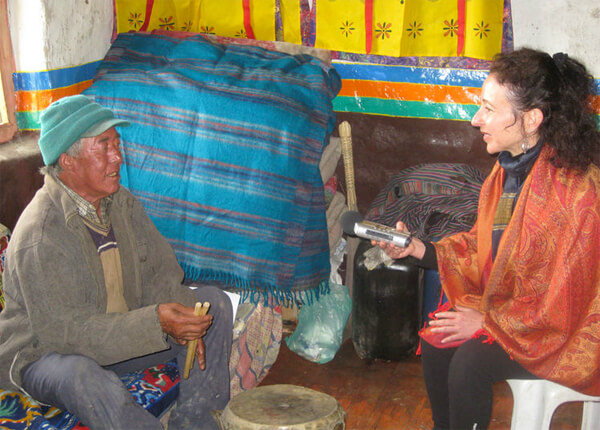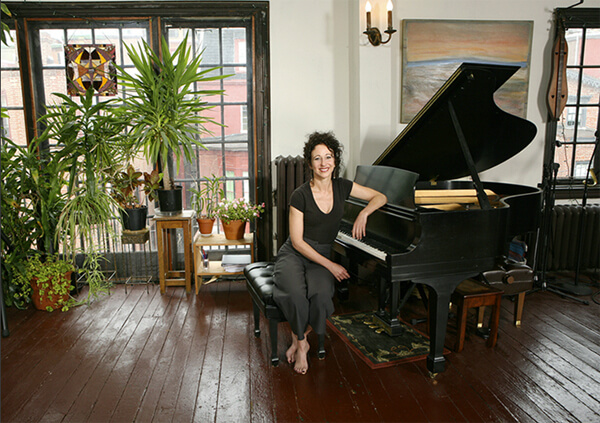 Saturday night at St. Paul the Apostle on Manhattan’s west side, the Schola Cantorum on Hudson (SCH) brought the audience their season’s final concert, Thresholds, based on the theme of healing. As artistic director and founder Dr. Deborah Simpkin King states in the program, this “theme was chosen in honor and commemoration of those lost, and those left suddenly and unexpectedly behind, by the terrorist attacks of ten years ago… it was our feeling that our national grieving had only barely gotten underway when war engulfed national attention, thereby short-circuiting the healing process.” To restore this process, the ensemble performed works based on texts that highlight the transitory nature of life’s events, and of life itself, from a wide range of cultures: pre-Colombian New World, medieval Europe, and the Himalayas.
Saturday night at St. Paul the Apostle on Manhattan’s west side, the Schola Cantorum on Hudson (SCH) brought the audience their season’s final concert, Thresholds, based on the theme of healing. As artistic director and founder Dr. Deborah Simpkin King states in the program, this “theme was chosen in honor and commemoration of those lost, and those left suddenly and unexpectedly behind, by the terrorist attacks of ten years ago… it was our feeling that our national grieving had only barely gotten underway when war engulfed national attention, thereby short-circuiting the healing process.” To restore this process, the ensemble performed works based on texts that highlight the transitory nature of life’s events, and of life itself, from a wide range of cultures: pre-Colombian New World, medieval Europe, and the Himalayas.
SCH is a 35-voice choir with an impressive collaborative mission. ‘Thresholds’ was sung with the Caldwell College Choir, the soloists were chosen from SCH membership, and the ensemble supports new music by organizing a Featured Composer Program, which this year highlighted the work of Ivo Antognini. His Life is a Circle is based on a text by Black Elk of the Oglala Sioux:
The sun comes forth and
Goes down again in a circle.
The moon does the same
And both are round.
Even the seasons form a great circle
in their changing
and always come back
to where they were.
This meditation on the cyclical nature of existence was captured with very gentle beauty by SCH, whose high and low voices wove around one another through the great vaulted space of the church.
Following the sparkle of wind chimes, a spare series of plucked harp notes, and an electronic track of droning voices, the choir achieved a very convincing medieval chant atmosphere with “Media Vita,” a chant by Irish monk Notker Balbalus (9th century), set by Michael McGlynn. The refrain pleads, “Holy God, holy and mighty, holy and merciful Savior / Do not give us over to the harshness of death” and the low voices imbued these lines with a humility and resignation pointing to acceptance of the chant’s opening and closing line, “In the midst of life we are in death.” Soloist Alexander Wentworth took advantage of the natural resonance of his space with sostenuto delivery of stark, unadorned phrases.
Following the intermission came the featured offering, the cantata Tse Go La by Andrea Clearfield, in the premiere of its chamber scoring (mixed and treble voices, electronics, piano, harp, flute and the original scoring for three percussionists). In 2008, Network for New Music commissioned the composer to collaborate with painter Maureen Drdak, whose art is inspired by Buddhist iconography. Together with cultural anthropologist Sienna Craig, they traveled to the remote Lo Monthang, a culturally Tibetan region which, since it is located in Nepal, escaped the cultural destruction that is still visited upon Chinese-occupied Tibet. Clearfield recorded over 130 gar glu (court songs) and tro glu (traditional folk songs) of Tashi Tsering, the last of the royal court singers of Lo Monthang. She sent cassette tapes of these recordings along with boom boxes to Lo Monthang to preserve the songs for posterity.

Andrea Clearfield
Tse Go La opened with a prologue which features a feverish repetition of the word do, Tibetan for ‘stone,’ which found kinship ringing out within this marble edifice. The first movement, Kye (birth) is a poem by Sienna Craig, a meditation on the mystery of the creation of life, and the marriage of matter and spirit. The Tibetan words for the elements earth, water, fire, wind, and space are whispered by the choir (Sa, lung, chu, me, nam kha), along with an electronic track of sounds derived from these elements, which Clearfield recorded in Lo Monthang.
Shar Ki Ri (mountain in the east), for treble choir, is punctuated with vocal percussion (‘tss, tss, tss’) that helps mark time for this folksong-inspired movement, which the audience is invited to imagine being sung to dancing. ‘Thresholds’ could also definitely apply to the space between these six movements, as they lead into and out of each other with the smoothness of time, and yet use time to delineate the introduction of a new musical frame of mind. The next movement, Tse Go La (at the threshold of this life) gave soprano Sara Livolsi and tenor Kerry Stubbs the chance to sing of the desire, awakened by nature, which seeks the union of marriage: “This high mountain pasture nurtures luscious grass, / Just as this is so, it is my karma to wed this beautiful bride.” A bass flute solo plumbs the depths of a valley as seen from these high mountain passes. Kusum, the next movement, climaxes in explosive percussion, followed by conch shells and flute, phasing in and out of unison. A lament is sung with doleful piano accompaniment, mourning the departure of a queen. The cantata closes with an aleatoric reprise of the “do” motif, and the singers empty the performance space in processional, ringing bowls in hand, the basses chanting the Heart Sutra mantra.

Andrea Clearfield
What impresses me the most about Andrea Clearfield’s compositional ethos is her fidelity to both the spirit and the form of Tibetan chant. When Stravinsky and his colleagues set out to recreate ancient pagan Russian rituals in Le Sacre du Printemps, they used considerable artistic license, and musicologists have sometimes pointed out that it shouldn’t be seen as an authentic ethnological treatise. The tremendous global upheavals in the last century have made plain the fragility of indigenous cultural traditions, and artists like Clearfield and her colleagues should be commended for celebrating these traditions in a way designed to save them from extinction, with a view to preserving their authenticity. This is not the routine, ritual music of detachment heard in a yoga class, but a more polished meditative exercise, the piano, harp and percussion poking and plucking out points in time while the choir chants in a weightless probing of space. Anthropology, musical elegance and creativity, and a spirit of interconnected human experience coexist in her work in an organic way, which obviates the question, “Is it activism, or is it art?”
—
Rob Wendt is a pianist / composer / music educator living in Astoria, NY. You can follow him on twitter: @RobWendt




















